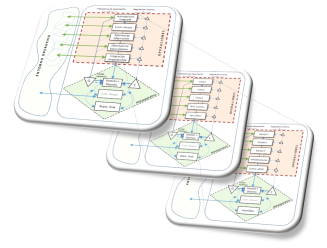
Digital communication flow in 2016 for Latin America, whose digital communications are practically spinning around a unique hub outside Latin America. It therefore exhibits an structural lack of self-organisation capacity.
By: José María Díaz-Nafría (Universidad de León, Spain | Munich University of Applied Sciences), Teresa Guarda (Universidad Estatal Península de Santa Elena, Ecuador)
Published in: K. Von Helmolt, D. Ittstein (eds.), Interkulturalität digital – Digitalisierung interkulturell?!, Hannover: Ibidem Verlag.
Abstract:
Intercultural life requires, first of all, a dense net of connections among people belonging to the same culture and with the components of the context in which this culture exists; secondly, a weaker but nevertheless effective network where interactions among different cultures take place. The former is a necessary condition for the very existence of cultural life and its capacity to evolve; the latter is necessary for communication and cooperation between different cultures, therefore, it creates the intercultural space where intercultural life properly exists.
The current digital networks, backed up by big-data technologies, connect people, processes, data, and things, turning information into actions, creating new capabilities and extraordinary opportunities. These digital networks allegedly enable a perfect symbiosis in the interaction between people and machines anywhere, at any time, using any device. In principle, as it is commonly stated, they seem to provide linkage between virtually everybody and everything, thus far exceeding the aforementioned basic requirements for intercultural life. Yet, what is the actual control we really have regarding this connectedness for individuals and cultures? How pervasive is this connectedness really? Is it accessible for everybody and every culture in the same way? What are the filtering mechanisms that make the signalling effective at different levels, and particularly among cultural and intercultural levels? …




